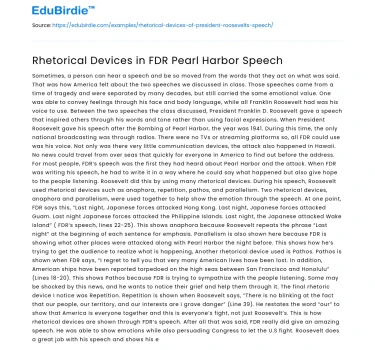Sometimes, a person can hear a speech and be so moved from the words that they act on what was said. That was how America felt about the two speeches we discussed in class. Those speeches came from a time of tragedy and were separated by many decades, but still carried the same emotional value. One was able to convey feelings through his face and body language, while all Franklin Roosevelt had was his voice to use. Between the two speeches the class discussed, President Franklin D. Roosevelt gave a speech that inspired others through his words and tone rather than using facial expressions.
When President Roosevelt gave his speech after the Bombing of Pearl Harbor, the year was 1941. During this time, the only national broadcasting was through radios. There were no TVs or streaming platforms so, all FDR could use was his voice. Not only was there very little communication devices, the attack also happened in Hawaii. No news could travel from over seas that quickly for everyone in America to find out before the address. For most people, FDR’s speech was the first they had heard about Pearl Harbor and the attack. When FDR was writing his speech, he had to write it in a way where he could say what happened but also give hope to the people listening. Roosevelt did this by using many rhetorical devices.
Save your time!
We can take care of your essay
- Proper editing and formatting
- Free revision, title page, and bibliography
- Flexible prices and money-back guarantee
During his speech, Roosevelt used rhetorical devices such as anaphora, repetition, pathos, and parallelism. Two rhetorical devices, anaphora and parallelism, were used together to help show the emotion through the speech. At one point, FDR says this, “Last night, Japanese forces attacked Hong Kong. Last night, Japanese forces attacked Guam. Last night Japanese forces attacked the Philippine Islands. Last night, the Japanese attacked Wake Island” ( FDR’s speech, lines 22-25). This shows anaphora because Roosevelt repeats the phrase “Last night” at the beginning of each sentence for emphasis. Parallelism is also shown here because FDR is showing what other places were attacked along with Pearl Harbor the night before. This shows how he’s trying to get the audience to realize what is happening, Another rhetorical device used is Pathos. Pathos is shown when FDR says, “I regret to tell you that very many American lives have been lost. In addition, American ships have been reported torpedoed on the high seas between San Francisco and Honolulu” (Lines 18-20). This shows Pathos because FDR is trying to sympathize with the people listening. Some may be shocked by this news, and he wants to notice their grief and help them through it. The final rhetoric device I notice was Repetition. Repetition is shown when Roosevelt says, ”There is no blinking at the fact that our people, our territory, and our interests are i grave danger” (Line 39). He restates the word “our” to show that America is everyone together and this is everyone’s fight, not just Roosevelt’s. This is how rhetorical devices are shown through FDR’s speech.
After all that was said, FDR really did give an amazing speech. He was able to show emotions while also persuading Congress to let the U.S fight. Roosevelt does a great job with his speech and shows his emotions through his voice. He is truly an amazing writer and president.






 Stuck on your essay?
Stuck on your essay?

